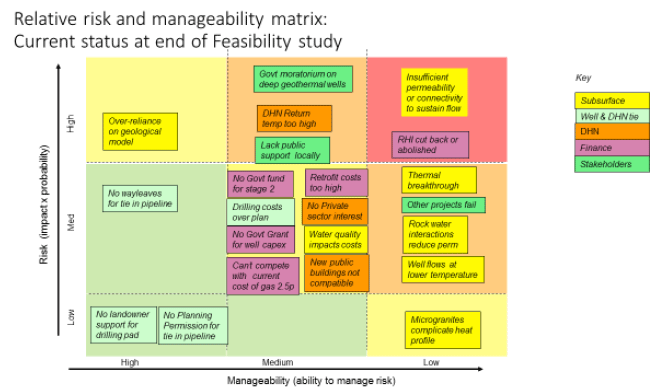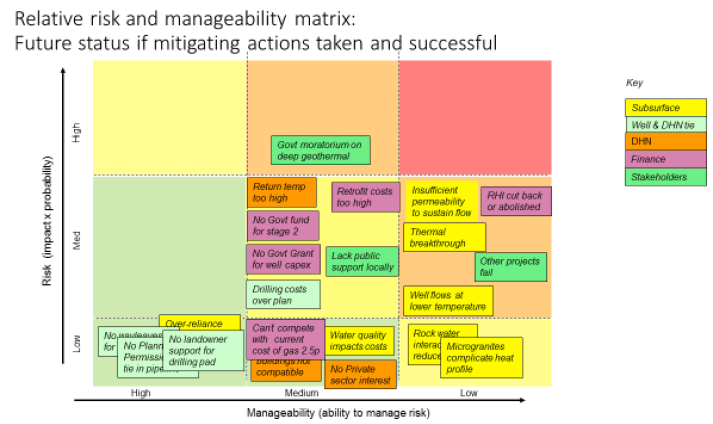Hill of Banchory geothermal energy project: feasibility report
Report of a study which explored the potential for a deep geothermal heat project at the Hill of Banchory, Aberdeenshire.
13. Risk Strategy
A risk and opportunity register has been compiled in this feasibility study. The register documents the current view of risks and opportunities and identifies potential actions that can be taken in the later stages of the project to reduce risks and access opportunities. In this project a risk is any issue that may lead to a loss in value; an opportunity can add value to the project. Risks and opportunities may be discrete events, such as loss of the RHI; or broader uncertainties, such as rock permeability being too low to give economic flow rates of hot water. Risks and opportunities have been recognised in all aspects of the project: subsurface; well design and tie in; District Heating Network; project financing; and stakeholder management. Risks have been ranked relatively from Low to High, where the ranking indicates both the potential impact on the project value if the risk materialises and the probability of the risk occurring. Risks are also ranked relatively according to the ability of the project to manage the risk, again from Low to High.
Risk Matrix
Figure 38 shows the current relative impact and manageability of risks included in the risk register which is in Appendix 2. The risks in the red top right hand corner are the most concerning as they have high impact and low manageability. The risks in the green bottom left hand corner are least significant, but should still be managed. Individual risks are colour coded by the area of the project.
Figure 38: Risk Matrix

Review of most significant risks
Insufficient permeability or connectivity to sustain flow
The largest impact risk is that having drilled a deep well into the granite the well does not flow at adequate rates. At this point there will be large sunk costs, with limited opportunities to utilise the well. The following possibilities can be considered in the next stage to assess alternative uses for a poor well:
1. Evaluate and make case for well stimulation to improve flow rates
2. Evaluate completing a closed loop system
3. Evaluate completing as a low flow system
4. Abandon the well and Supply heat to expanded DHN from alternate sources, e.g. biomass, gas
5. Evaluate maintaining the well for research
There are further geological and geophysical studies that have been outlined in chapter 19 (Next Steps) which can reduce the risk of an unsuccessful well, but there will be residual risk prior to drilling that is irreducible given that this is the first geothermal well in the area.
RHI cutback or abolition
The project economics include an assumption that RHI remain available for deep geothermal wells as current. The value of RHI to the project is remarked on in Chapter 10. The recent changes in FIT and uncertainty about long term strategy towards renewable energy incentives at UK Government level raises the probability of loss or reduction of the RHI. The project can work with industry bodies to lobby for maintenance and certainty in policy.
District heating return temperature too high
There is a risk that the flowing temperature from the wellhead is too low to be easily utilised in the existing District Heating Network. Action can be taken to understand the range of useable temperatures, engineering solutions and costs, and depth of well prior to drilling, but some risk will remain until well productivity and temperature is assured.
Lack of general public support locally
The project plans an expansion of the District Heating Network into new public sector buildings and private sector homes. It will involve construction of pipelines for District Heating and to tie in the well. Each of these has an element of risk, which have been captured separately. Overall there is an additional risk that the public in the project area are not supportive, raising objections, or misconceiving the risks through association with unpopular deep drilling activities in other parts of the UK. Early and frequent stakeholder and public engagement will mitigate all of these general and specific risks.
Government moratorium on deep geothermal wells:
There is presumably a risk that the existing Scottish Government moratorium on fracking could be extended to deep geothermal wells if there is likelihood that stimulation is required to deliver acceptable well productivity - albeit there is a vast difference in scale and risks between the two types of operation. Action would need to be taken to clearly articulate what the project will consider, and close cooperation with Government and local councils will be required to manage both the reality and the perceptions.
Thermal breakthrough; rock water interactions reduce permeability; well flows at lower temperature
These three risks are all essentially unpredictable uncertainties of the subsurface geology that will manifest themselves after drilling and after initial production. The project can attempt to cover acceptable uncertainty ranges in the economic evaluation, and can design in mitigations but cannot fully reduce these uncertainties.
Opportunity to design and drill a test bore
The project may evaluate drilling a shallow cored borehole extending several hundred metres below the weathering zone. This bore would aim to determine whether soluble minerals (e.g. calcite) form a significant component of the filling in the fracture network in the granite, and whether there is evidence for Recent or ongoing dissolution of soluble minerals (this would increase the likelihood that 'flow zones' in de-mineralised fractures occur at depth). A test bore may also measure the geothermal gradient, and possibly recover water samples.
All the risks and opportunities are described in the register in Appendix 3.
Risks after mitigation
Figure 39 shows how the risks can be influenced if all mitigating actions are taken and are successful.
Figure 39: Risk Matrix Post-Mitigation

Contact
There is a problem
Thanks for your feedback